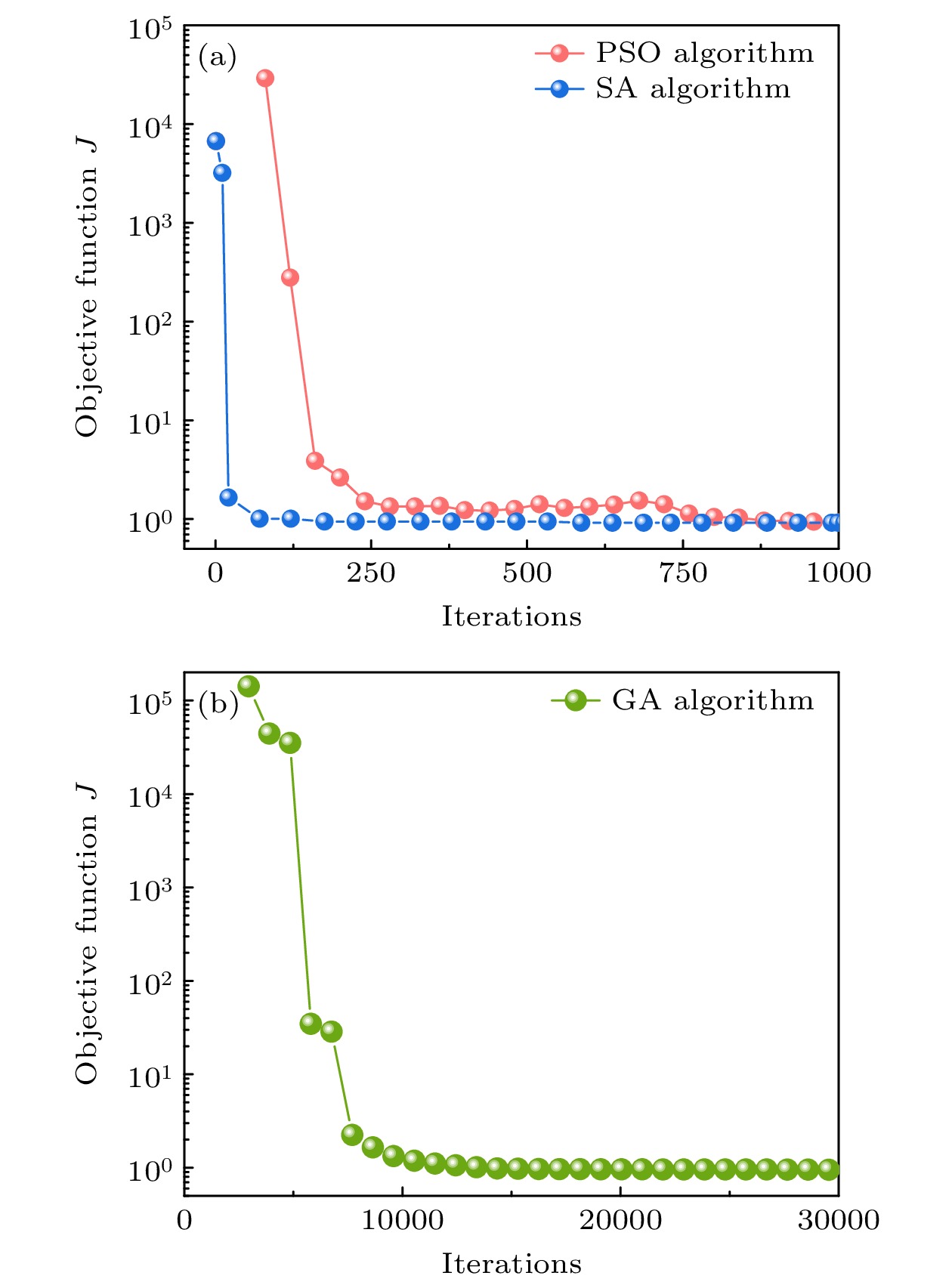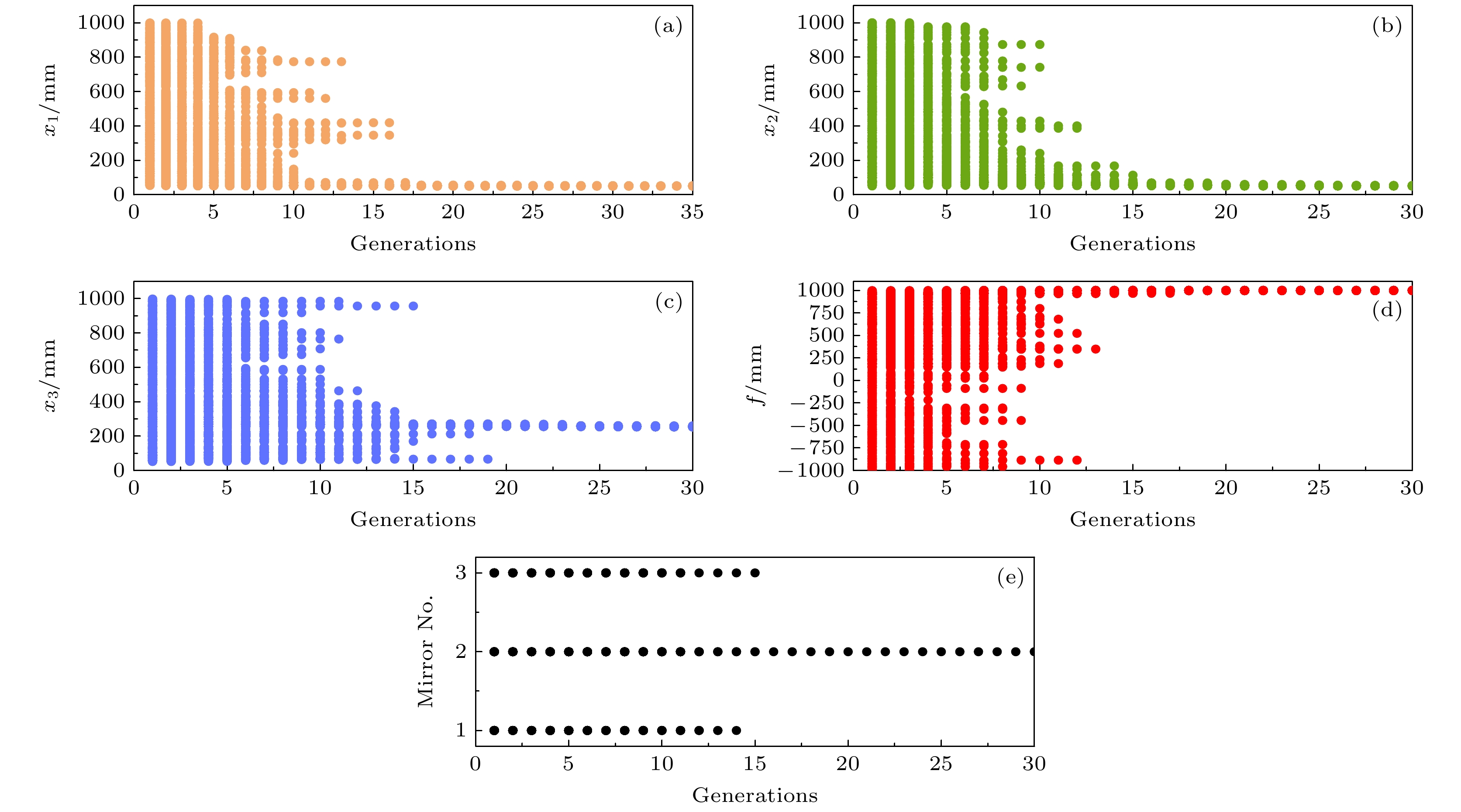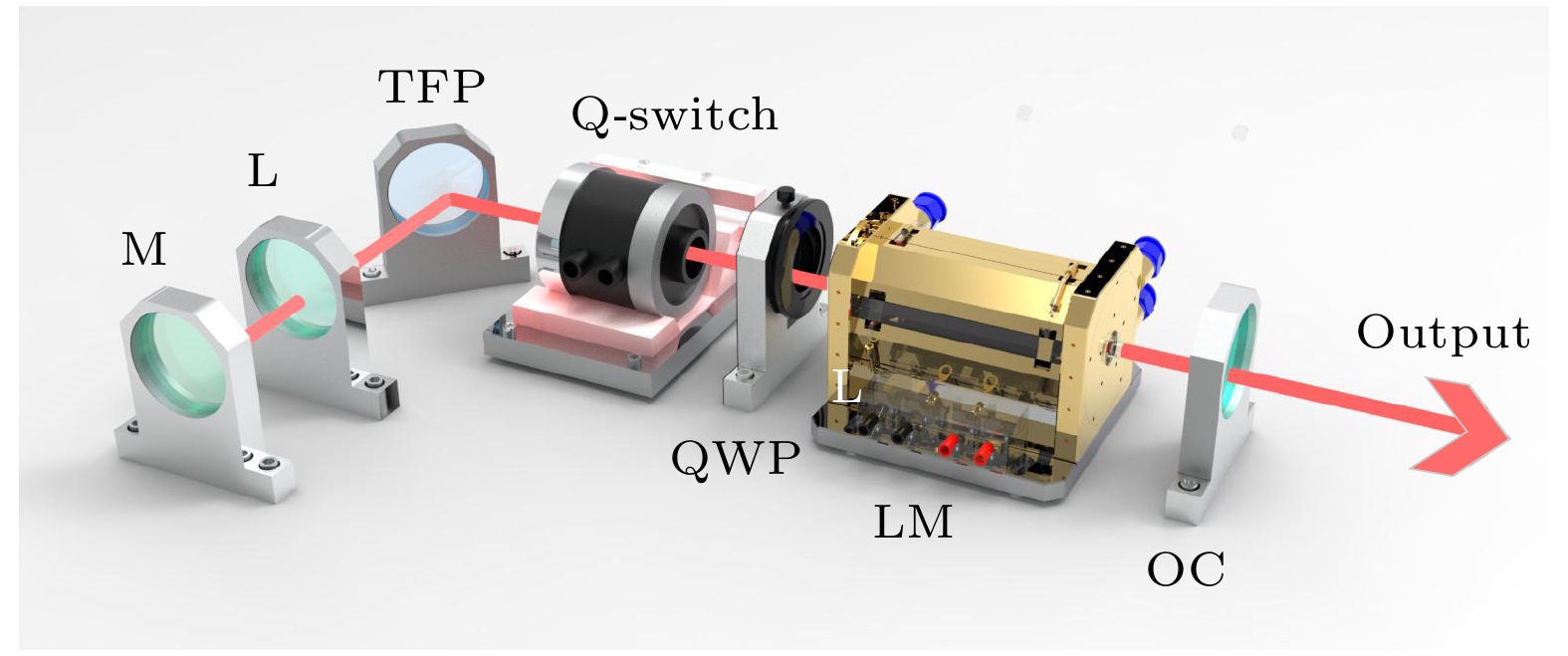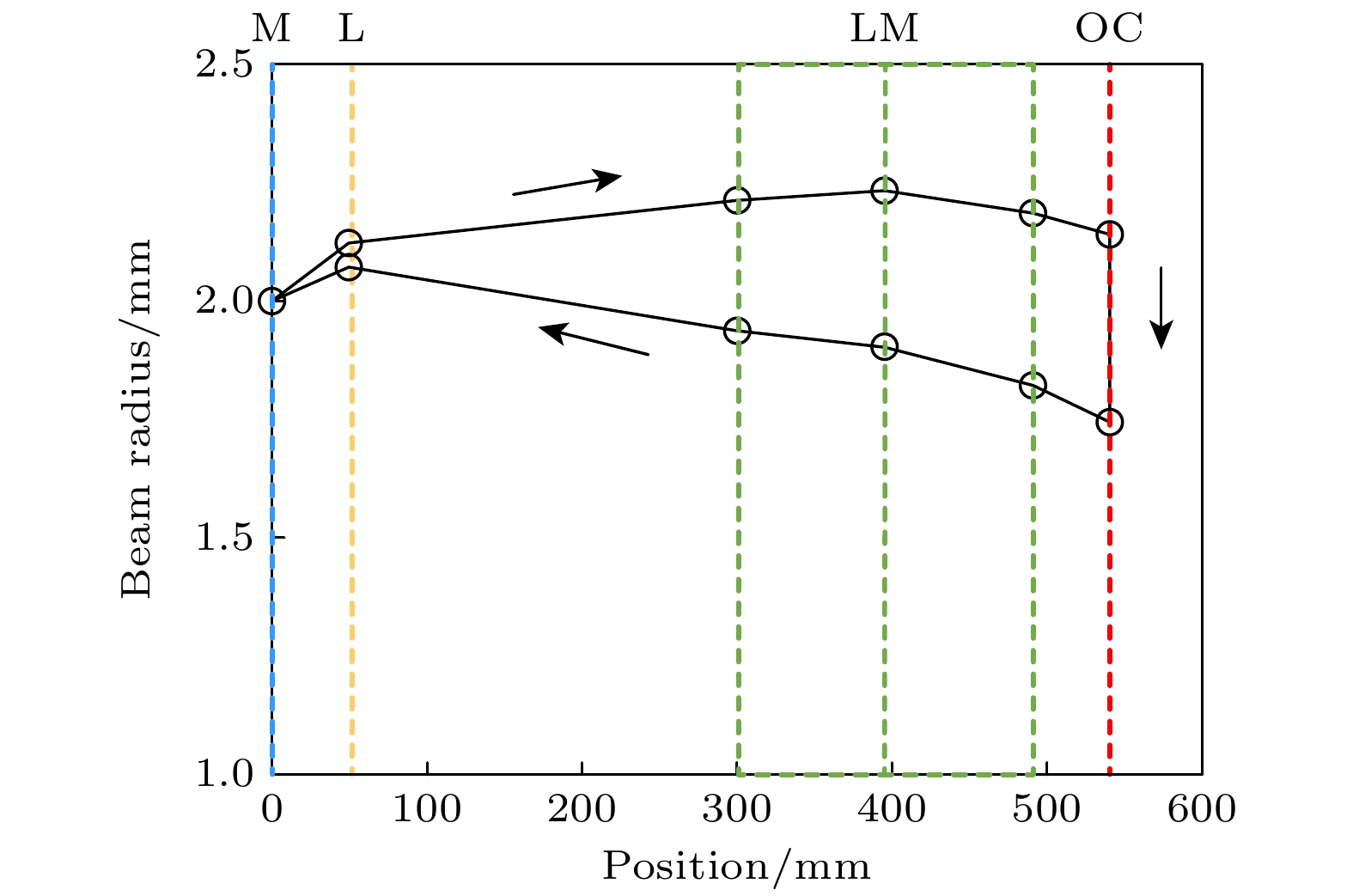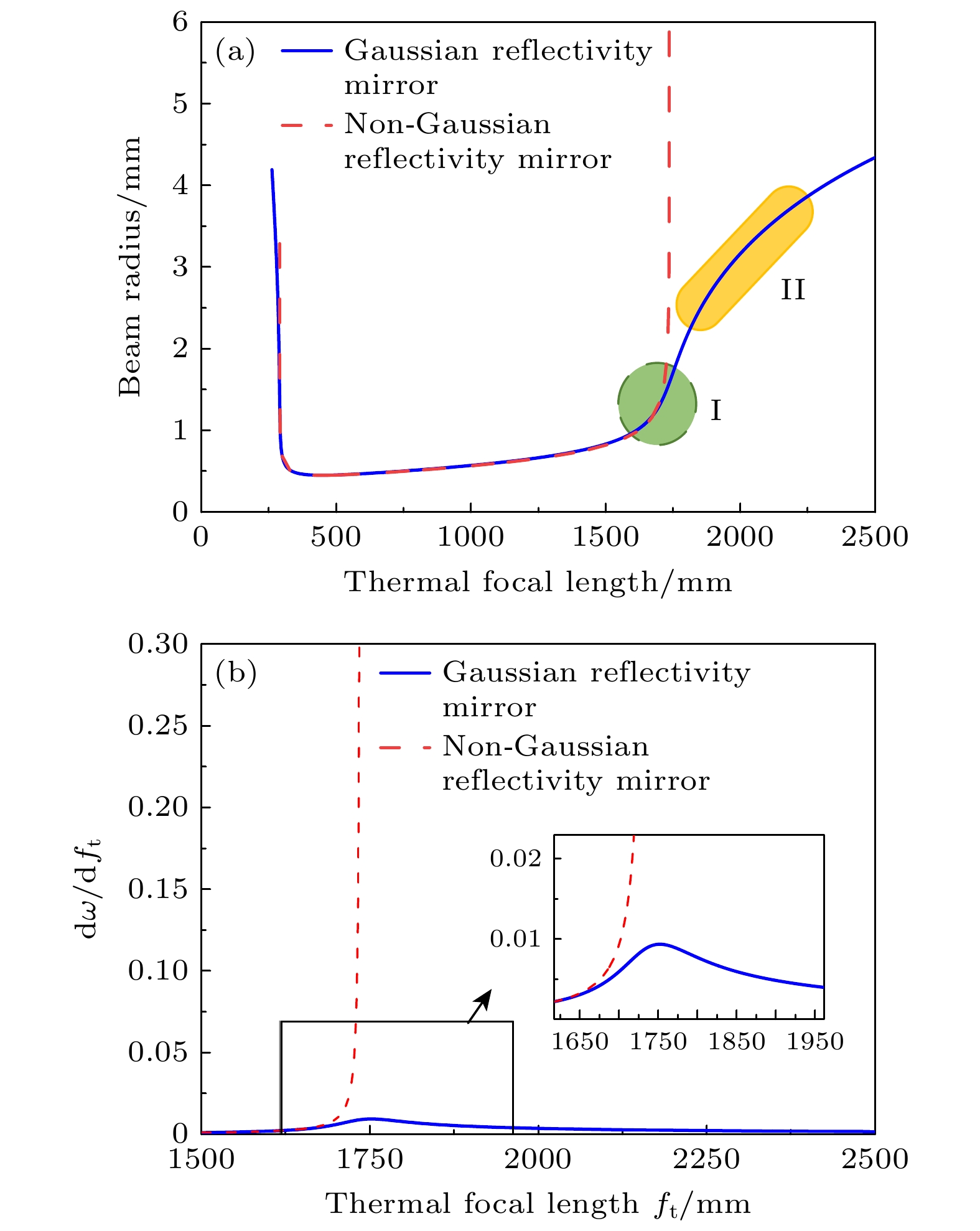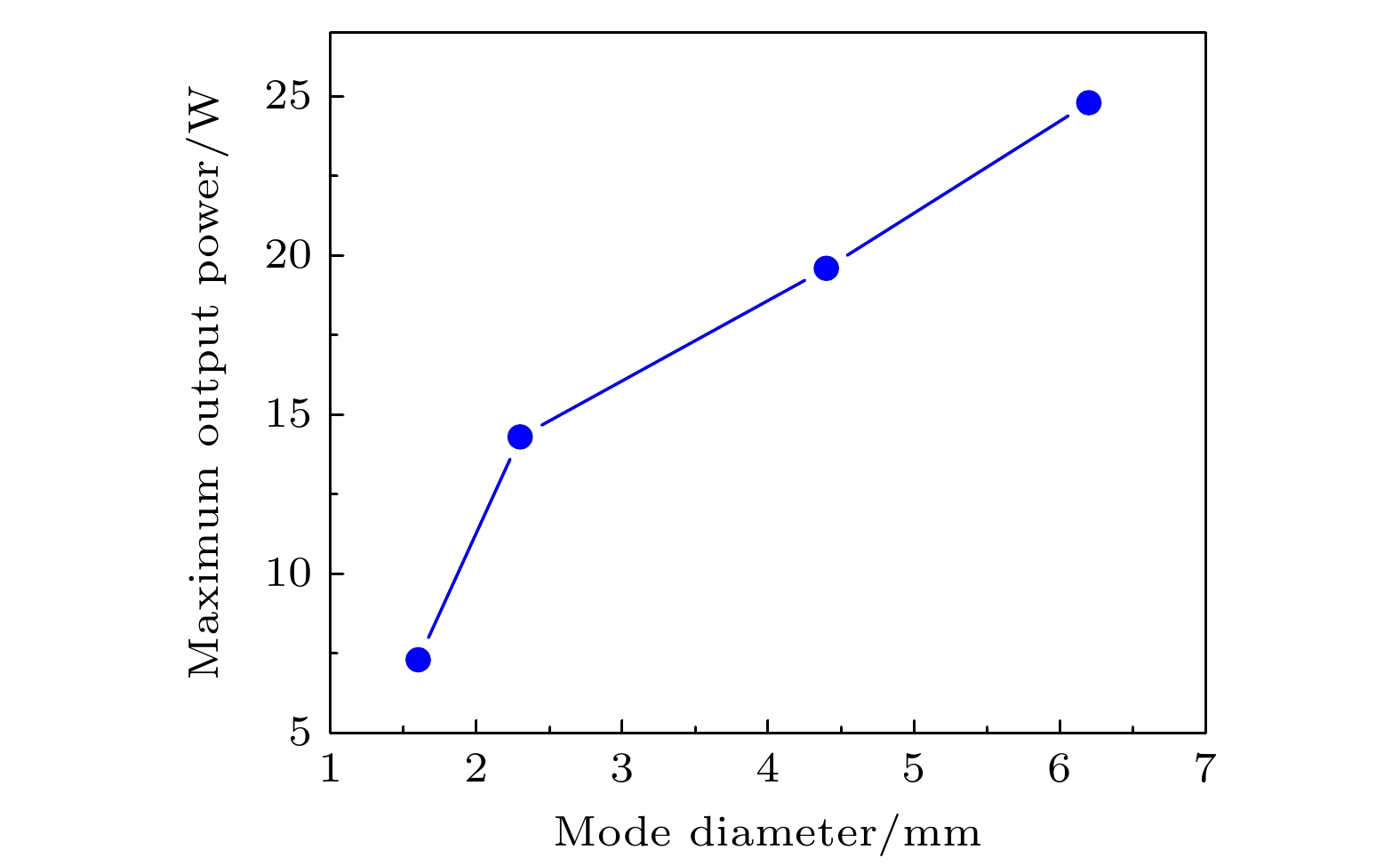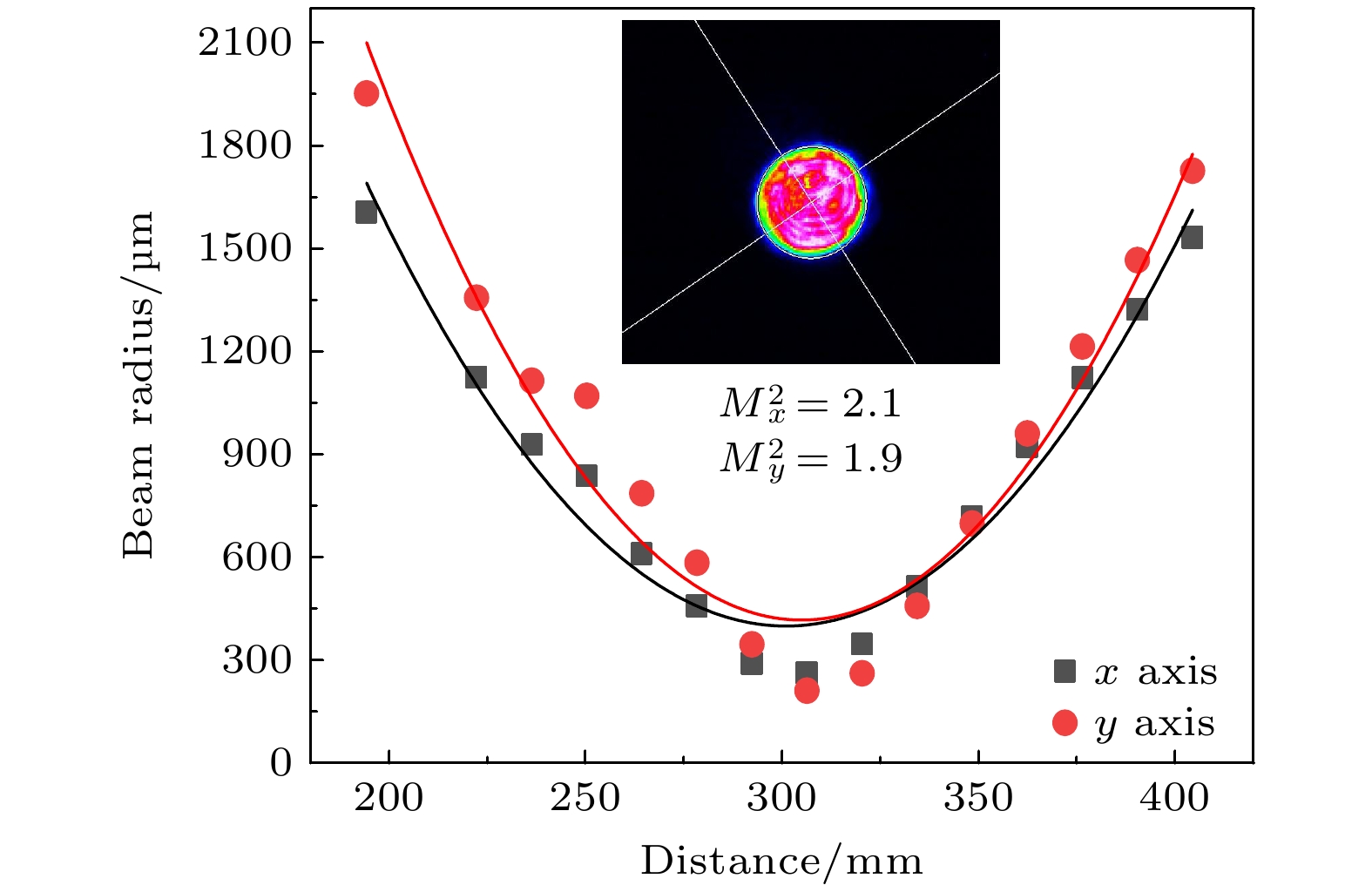-
本文基于人工智能算法提出了一种宽稳区大模场激光振荡器的优化设计方法. 通过构建谐振腔的光场传播模型, 设计了多目标优化函数, 并利用人工智能算法对腔段长度、透镜焦距及高斯镜选型多个维度进行全局优化. 在设定的热焦距范围内, 本文对模拟退火、粒子群优化和遗传算法等多种算法进行比对, 最终实现了复杂多维参数空间中最优解的高效搜索. 经过实验验证, 优化后的谐振腔在长度为540 mm的腔长范围内实现了100 Hz和190 mJ, 光束质量为$M_x^2$ = 2.1, $M_y^2$ = 1.9的7 ns脉宽的激光输出. 优化后的谐振腔热稳定曲线在大模场运转区间的斜率显著变缓, 有效扩大了谐振腔的热稳区, 从而保障了高重复频率激光器的稳定运行. 该研究有望为宽稳区大模场纳秒激光振荡器的设计提供参考.This study presents an optimization method of generating a wide stable-zone, large mode field operation nanosecond laser oscillator based on artificial intelligence algorithms. The work is motivated by the need of the large mode field laser cavities in compact size with variable thermal focal length. A physics model of light field propagation inside the resonator is established by combining thermal lensing tolerance. A multi-objective optimization function is designed to simultaneously balance the beam quality, thermal stability, and cavity compactness. Several algorithms, such as simulated annealing, particle swarm optimization, and genetic algorithms are compared, and ultimately, efficient searching for optimal solutions in complex multi-dimensional parameter spaces is achieved. In the system design, the parameters of cavity segment length, intracavity lens, and Gaussian mirror (VRM) are optimized. Therefore, an optimized cavity structure is experimentally implemented and Q-switching operations are perform. The results demonstrate stable laser output at 100 Hz repetition rate with 190 mJ pulse energy and 7 ns pulse width, and beam quality factors $ M_x^2 $ = 2.1 and $ M_y^2 $ = 1.9 respectively, and the total length of the cavity is only 540 mm, which demonstrates the compactness of laser design. Furthermore, numerical simulations are conducted to compare a variety of resonator configurations and assess the influence of different parameters on the cavity’s thermal stability. After the optimization, the thermal stability curve of the laser resonator shows a significant decrease in slope near the large-mode-field region, indicating an improvement in thermal length adaptability. This enhancement is crucial for ensuring long-term stable operation of high-repetition-rate nanosecond laser oscillators. In summary, this study provides an efficient approach for designing compact, thermally stable, large-mode-area resonators, and valuable insights into designing compact laser with high power output.
-
Keywords:
- solid-state laser /
- large mode area /
- artificial intelligence /
- multi-parameter optimization
[1] Zhu Z D, Lv S W, Zhang H Y, Hui Y L, Lei H, Li Q 2021 Opt. Express 29 32325
 Google Scholar
Google Scholar
[2] Li C Y, Lu C Q, Li C, Yang N, Li Y, Yang Z, Han S, Shi J F, Zhou Z W 2017 Opt. Commun. 394 1
 Google Scholar
Google Scholar
[3] Li C Y, Lu C Q, Li C, Zang Y N, Yang Z, Han S, Li Y, Yang N, Shi J F, Zhou Z W 2017 Opt. Commun. 56 116115
 Google Scholar
Google Scholar
[4] Fan Z W, Qiu J S, Kang Z J, Chen Y Z, Ge W Q, Tang X X 2017 Light-Sci. Appl. 6 e17004
 Google Scholar
Google Scholar
[5] Lu S W, Gao M, Yang Y, Zhu R, Hou X, Sun J F, Chen W B, Zhu X L 2019 Appl. Opt. 58 7517
 Google Scholar
Google Scholar
[6] Qi Y F, Zhu X L, Lou Q H, Ji J H, Dong J X, Wei R R 2007 J. Opt. Soc. Am. B-Opt. Phys. 24 1042
 Google Scholar
Google Scholar
[7] 沈骁, 邹辉, 郑锐林, 郑加金, 韦玮 2015 64 024210
 Google Scholar
Google Scholar
Shen X, Zhou H, Zhen R L, Zhen J J, Wei W 2015 Acta Phys. Sin. 64 024210
 Google Scholar
Google Scholar
[8] 周王哲, 李雪鹏, 杨晶, 杨天利, 王小军, 刘炳杰, 王浩竹, 杨俊波, 彭钦军 2023 72 014204
 Google Scholar
Google Scholar
Zhou W Z, Li X P, Yang J, Yang T L, Wang X J, Liu B J, Wang H Z, Yang J B, Peng Q J 2023 Acta Phys. Sin. 72 014204
 Google Scholar
Google Scholar
[9] Murdough M P, Denman C A 1996 Appl. Opt. 35 5925
 Google Scholar
Google Scholar
[10] Cerullo G, Desilvestri S, Magni V, Svelto O 1993 Opt. Quantum Electron. 25 489
 Google Scholar
Google Scholar
[11] 薄勇, 耿爱丛, 毕勇, 孙志培, 杨晓东, 李瑞宁, 崔大复, 许祖彦 2006 55 1171
 Google Scholar
Google Scholar
Bo Y, Geng A C, Bi Y, Sun Z P, Yang X D, Li R N, Cui D F, Xu Z Y 2006 Acta Phys. Sin. 55 1171
 Google Scholar
Google Scholar
[12] 何广源, 郭靖, 焦中兴, 王彪 2012 61 094217
 Google Scholar
Google Scholar
He G Y, Guo J, Jiao Z X, Wang B 2012 Acta Phys. Sin. 61 094217
 Google Scholar
Google Scholar
[13] Siegman A E 1974 Appl. Opt. 13 353
 Google Scholar
Google Scholar
[14] Liu Q, Liu J, Gong M 2011 Appl. Opt. 50 1186
 Google Scholar
Google Scholar
[15] 韩昌昊, 穆宇, 罗辉, 韩隆, 方聪, 王思博, 魏磊 2024 激光与红外 54 179
Han C H, Mu Y, Luo H, Han L, Fang C, Wang S B, Wei L 2024 Laser Infrared 54 179
[16] Hauck R, Kortz H P, Weber H 1980 Appl. Opt. 19 598
 Google Scholar
Google Scholar
[17] Woodward R I, Kelleher E J R 2016 Sci. Rep. 6 37616
 Google Scholar
Google Scholar
[18] Fang Z W, Pu G Q, Xu Y X, Hu W S, Yi L L 2023 Opt. Express 31 41794
 Google Scholar
Google Scholar
[19] Shi H D, Fan R H, He C F, Wang J Y, Yang S, Xu M, Sun H Y, Li Y C, Fu Q 2024 Photonics 11 164
 Google Scholar
Google Scholar
[20] Liu Z C, Dang Z B, Liu Z X, Li Y, He X, Dai Y C, Chen Y X, Peng P, Fang Z Y 2023 Photonics Res. 11 695
 Google Scholar
Google Scholar
[21] 王宁, 陆雨田, 孔勇 2004 中国激光 31 1317
Wang N, Lu Y T, Kong Y 2004 Chin. J. Lasers 31 1317
[22] Kirkpatrick S, Gelatt C, Vecchi M 1983 Science 220 671
 Google Scholar
Google Scholar
[23] 赵知劲, 徐世宇, 郑仕链, 杨小牛 2009 58 5118
 Google Scholar
Google Scholar
Zhao Z J, Xu S Y, Zheng S L, Yang X N 2009 Acta Phys. Sin. 58 5118
 Google Scholar
Google Scholar
[24] Shapiro J 2001 Machine Learning and Its Applications: Advanced Lectures (Berlin, Heidelberg) 2001 pp146–168
[25] Li X P, Yang J, Zhang M S, Yang T L, Wang X J, Peng Q J 2022 Chin. Phys. B 31 084207
 Google Scholar
Google Scholar
-
图 3 基于遗传算法的谐振腔参数优化过程 (a)腔段长度$ {x_1} $随进化代数的变化; (b) 腔段长度${x_2}$随进化代数的变化; (c)腔段长度${x_3}$随进化代数的变化; (d)可调透镜焦距$f$的优化轨迹; (e) 光学参数组$({w_{\text{m}}}, {R_0}, {R_{\text{c}}})$选择随代数的演化, 算法在20代后趋于稳定, 最终选定参数组2 (${w_{\text{m}}} = 3{\mkern 1 mu} {\text{ mm}}, {R_{\text{c}}}{\text{ }} = - 1500{\mkern 1 mu} {\text{ mm}}, {R_0} = 0.3$).
Fig. 3. Optimization process of resonator parameters via genetic algorithm: (a) Evolution of cavity segment ${x_1}$; (b) evolution of cavity segment ${x_2}$; (c) evolution of cavity segment ${x_3}$; (d) optimization trajectory of adjustable lens focal length $f$; (e) selection of optical parameter groups $({w_{\text{m}}}, {R_0}, {R_{\text{c}}})$ across generations, the algorithm converges after 20 generations, ultimately selecting parameter group 2 (${w_{\text{m}}} = 3{\mkern 1 mu} {\text{ mm}}, {R_{\text{c}}}{\text{ }} = - 1500{\mkern 1 mu} {\text{ mm}}, {R_0} = 0.3$).
图 4 实验装置示意图. M为高反射后镜, L为平凸透镜, TFP为1064 nm薄膜偏振片, QWP为1/4波片, LM为激光模块, OC为输出耦合镜
Fig. 4. Experimental setup. M represents high-reflectivity rear mirror, L represents plano-convex lens, TFP represents thin-film polarizer at 1064 nm, QWP represents quarter-wave plate, LM represents laser module, OC represents output coupler.
图 6 (a)晶体中心位置基模光斑半径与热焦距的关系, 其中红虚线OC为非高斯镜, 蓝实线OC为高斯镜, I为传统热近非稳区, II为高斯镜非稳区; (b)不同耦合输出器下, 谐振腔模场半径$\omega $对焦距${f_{\text{t}}}$的导数变化趋势
Fig. 6. (a) Relationship between the fundamental mode beam radius at the crystal center and the thermal focal length, red dashed line OC as a non-Gaussian mirror, blue solid line OC as a Gaussian mirror, I represents traditional thermal near-unstable region, II represents Gaussian mirror unstable region; (b) the derivative of the resonator mode radius $\omega $ with respect to focal length ${f_{\text{t}}}$ under different output couplers.
表 1 高斯镜规格参数
Table 1. Specifications of Gaussian mirrors.
高斯镜
编号N曲率半径
Rc/mm中心反射率 膜斑半径
${\omega _{\text{m}}}$/mm1 –700 0.35 4 2 –1500 0.3 3 3 –2000 0.2 2 -
[1] Zhu Z D, Lv S W, Zhang H Y, Hui Y L, Lei H, Li Q 2021 Opt. Express 29 32325
 Google Scholar
Google Scholar
[2] Li C Y, Lu C Q, Li C, Yang N, Li Y, Yang Z, Han S, Shi J F, Zhou Z W 2017 Opt. Commun. 394 1
 Google Scholar
Google Scholar
[3] Li C Y, Lu C Q, Li C, Zang Y N, Yang Z, Han S, Li Y, Yang N, Shi J F, Zhou Z W 2017 Opt. Commun. 56 116115
 Google Scholar
Google Scholar
[4] Fan Z W, Qiu J S, Kang Z J, Chen Y Z, Ge W Q, Tang X X 2017 Light-Sci. Appl. 6 e17004
 Google Scholar
Google Scholar
[5] Lu S W, Gao M, Yang Y, Zhu R, Hou X, Sun J F, Chen W B, Zhu X L 2019 Appl. Opt. 58 7517
 Google Scholar
Google Scholar
[6] Qi Y F, Zhu X L, Lou Q H, Ji J H, Dong J X, Wei R R 2007 J. Opt. Soc. Am. B-Opt. Phys. 24 1042
 Google Scholar
Google Scholar
[7] 沈骁, 邹辉, 郑锐林, 郑加金, 韦玮 2015 64 024210
 Google Scholar
Google Scholar
Shen X, Zhou H, Zhen R L, Zhen J J, Wei W 2015 Acta Phys. Sin. 64 024210
 Google Scholar
Google Scholar
[8] 周王哲, 李雪鹏, 杨晶, 杨天利, 王小军, 刘炳杰, 王浩竹, 杨俊波, 彭钦军 2023 72 014204
 Google Scholar
Google Scholar
Zhou W Z, Li X P, Yang J, Yang T L, Wang X J, Liu B J, Wang H Z, Yang J B, Peng Q J 2023 Acta Phys. Sin. 72 014204
 Google Scholar
Google Scholar
[9] Murdough M P, Denman C A 1996 Appl. Opt. 35 5925
 Google Scholar
Google Scholar
[10] Cerullo G, Desilvestri S, Magni V, Svelto O 1993 Opt. Quantum Electron. 25 489
 Google Scholar
Google Scholar
[11] 薄勇, 耿爱丛, 毕勇, 孙志培, 杨晓东, 李瑞宁, 崔大复, 许祖彦 2006 55 1171
 Google Scholar
Google Scholar
Bo Y, Geng A C, Bi Y, Sun Z P, Yang X D, Li R N, Cui D F, Xu Z Y 2006 Acta Phys. Sin. 55 1171
 Google Scholar
Google Scholar
[12] 何广源, 郭靖, 焦中兴, 王彪 2012 61 094217
 Google Scholar
Google Scholar
He G Y, Guo J, Jiao Z X, Wang B 2012 Acta Phys. Sin. 61 094217
 Google Scholar
Google Scholar
[13] Siegman A E 1974 Appl. Opt. 13 353
 Google Scholar
Google Scholar
[14] Liu Q, Liu J, Gong M 2011 Appl. Opt. 50 1186
 Google Scholar
Google Scholar
[15] 韩昌昊, 穆宇, 罗辉, 韩隆, 方聪, 王思博, 魏磊 2024 激光与红外 54 179
Han C H, Mu Y, Luo H, Han L, Fang C, Wang S B, Wei L 2024 Laser Infrared 54 179
[16] Hauck R, Kortz H P, Weber H 1980 Appl. Opt. 19 598
 Google Scholar
Google Scholar
[17] Woodward R I, Kelleher E J R 2016 Sci. Rep. 6 37616
 Google Scholar
Google Scholar
[18] Fang Z W, Pu G Q, Xu Y X, Hu W S, Yi L L 2023 Opt. Express 31 41794
 Google Scholar
Google Scholar
[19] Shi H D, Fan R H, He C F, Wang J Y, Yang S, Xu M, Sun H Y, Li Y C, Fu Q 2024 Photonics 11 164
 Google Scholar
Google Scholar
[20] Liu Z C, Dang Z B, Liu Z X, Li Y, He X, Dai Y C, Chen Y X, Peng P, Fang Z Y 2023 Photonics Res. 11 695
 Google Scholar
Google Scholar
[21] 王宁, 陆雨田, 孔勇 2004 中国激光 31 1317
Wang N, Lu Y T, Kong Y 2004 Chin. J. Lasers 31 1317
[22] Kirkpatrick S, Gelatt C, Vecchi M 1983 Science 220 671
 Google Scholar
Google Scholar
[23] 赵知劲, 徐世宇, 郑仕链, 杨小牛 2009 58 5118
 Google Scholar
Google Scholar
Zhao Z J, Xu S Y, Zheng S L, Yang X N 2009 Acta Phys. Sin. 58 5118
 Google Scholar
Google Scholar
[24] Shapiro J 2001 Machine Learning and Its Applications: Advanced Lectures (Berlin, Heidelberg) 2001 pp146–168
[25] Li X P, Yang J, Zhang M S, Yang T L, Wang X J, Peng Q J 2022 Chin. Phys. B 31 084207
 Google Scholar
Google Scholar
计量
- 文章访问数: 398
- PDF下载量: 9
- 被引次数: 0














 下载:
下载:
